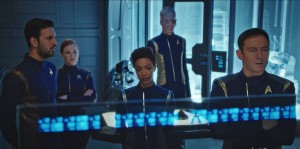Star Trek: Discovering Something New
Review of Star Trek: Discovery, Season One
Hannah Dewhurst
In 2017, when the CBS exclusive show Star Trek: Discovery (a.k.a. Discovery) premiered, many fans were skeptical, fearing that it was too much of a departure from previous Star Trek series to be any good. However, as the first season of Discovery progressed, both old fans and new realized how fantastic it was – not only because of the things that stayed the same, but because of the things that it did differently.
Discovery’s plot revolves around Michael Burnham, played by actress Sonequa Martin-Green, an orphaned human who was raised on the planet Vulcan by Sarek and Amanda. For those familiar with Stark Trek, yes, they are the same Sarek and Amanda who parented Spock. This show is set in between Star Trek: Enterprise and The Original Series, occurring approximately ten years before Kirk takes command of the Enterprise. In the first two episodes, Commander Burnham discovers a Klingon Warship in Federation Space and, directly disobeying the orders of her captain, provokes the Klingons, as they are known to be a warmongering species. Her action eventually results in both the beginning of a war and the death of Burnham’s captain, Phillipa Georgiou (Michelle Yeoh). Burnham is sentenced to life in prison for mutiny.
While on the way to the prison colony, Burnham’s ship is met by the USS Discovery, a science vessel under the command of Captain Gabriel Lorca (Jason Isaacs). Onboard the Discovery, Michael finds out that the ship has been experimenting with a new form of space travel through what is called “the mycelial network,” that allows them to get anywhere in the universe in an instant. Despite her life sentence, Burnham is invited by Lorca to become a part of the crew. She accepts the offer, and the series kicks off.
The second half of the season brings even more twists and turns as the crew of the USS Discovery are thrown into a parallel universe. In this mirror universe, humans (known as “Terrans”) are a cruel, xenophobic people, and the crew must adapt to this new world or risk being found out and killed. Because the characters are forced so far out of their comfort zones, the actors are given the opportunity to truly show their prowess. The show’s beautiful design is also given a chance to shine in the second season, as new sets and costumes are introduced. From the gold-armored Terran uniforms to the Imperial Palace, each element is simultaneously foreign and familiar.
In the second half of the season, Michael discovers that her deceased former captain, Phillipa Georgiou, is not only alive in the mirror universe, but is the emperor of the Terran Empire. Though Georigou is initially present only in the first two episodes, she returns in the second half of the season, completely different than before. Mirror Georgiou, a kick-butt, no-nonsense, bad girl, is another fan favorite character who adds life and interest to the story any time she is on screen. And, as if Discovery didn’t already have enough great antagonists, it is revealed that Captain Lorca is secretly a criminal from the mirror universe, who fled to the main universe after killing Mirror Burnham.
One of the best parts of Discovery is just how stunningly beautiful it is. From the design of the ship itself, to the detailed makeup of the aliens, to the beauty of the planets they explore – whether they be real locations or computer-generated – nearly every episode brings something new to marvel at. In particular, the design of the Klingons is astounding. So much care, love, and attention were poured into these characters, which is especially important because Klingons play a massive role throughout the series. There are twenty-four different houses of Klingons, and the members of each of these houses is designed with different physical features and costumes. Three-million dollars was spent creating the Klingon burial ship, the main location where we see Klingons throughout the series. Other sets, such as the USS Discovery itself and the Imperial Palace in the mirror universe are equally incredible. Even more delicate areas of design, such as costumes and makeup, are done beautifully, with details hiding in every centimeter.
Yet for how incredible the design is, the actors and characters manage to top them. One of the best characters in the entire series is Ensign Sylvia Tilly (Mary Wiseman), Michael’s cheerful, outspoken, and innocent roommate. From the moment she is introduced in episode three, Tilly’s naive smiles and nervous giggles capture the audience’s heart and never lets go. Tilly is especially heartwarming when put next to the cold, blunt Michael Burnham. When Ensign Tilly first meets Michael Burnham, she comments, “The only female Michael I’ve ever heard of is Michael Burnham the mutineer. You’re not that Michael, are you?” only to realize that her new roommate is indeed that Michael. Mary Wiseman’s expression perfectly displays just how horrifying this realization is to Tilly.
Along with Wiseman, other outstanding actors include Anthony Rapp, Michelle Yeoh, and Jason Isaacs — who is best known for his role as Lucius Malfoy in the Harry Potter movies — as Captain Lorca. For the role of Lorca, Isaacs won an Empire Award for Best TV Actor. Shazad Latif also delivers an incredible performance as both Lieutenant Ash Tyler – Burnham’s charming love interest – and as (SPOILER!!) Voq, the Klingon “Torchbearer” who has his body reconstructed in order to appear human.
Without a doubt, it is Shazad Latif’s character(s) that form my personal favorite part of Discovery’s first season. When first introduced, Ash Tyler is explained to be a Starfleet officer who has been kept by the Klingons as a prisoner of war. He is rescued by Captain Lorca and Burnham, joins the crew, and soon develops a relationship with Michael. Throughout this, Tyler begins to have flashbacks of his torture while onboard the Klingon ships. Not only are the flashbacks themselves shot and lit in the most terrifying way possible, with shaky cameras, dim lighting, whirling machines, and endless screaming, but Latif’s expressions coming out of them are amazing. There is never a moment when his terror (and he spends a lot of time being terrified) feels forced. However, as the season progresses, Tyler’s flashbacks become more extreme and debilitating, especially while around a Klingon named L’Rell (Mary Chieffo). Following an attempt by the ship’s doctor, Hugh Culber (Wilson Cruz), to explain the odd scar tissue around Tyler’s organs, Tyler lashes out, kills Culber with his bare hands, and walks away to join Burnham on an away mission. When it is finally revealed that Ash Tyler is, in fact, Voq, Latif’s acting sells every bit of this reveal. In an instant, he goes from a kind-hearted lieutenant, struggling to accept the fact that he is not who he believed he was, to a violent, hateful Klingon warrior with a lust for blood. Every time he is on screen, whether it be as Tyler or as Voq, Latif delivers incredibly.
Unfortunately, Discovery is not without its flaws. As previously mentioned, the design of the Klingon ships, costumes, and makeup is phenomenal; however, almost all the scenes with Klingons have their words translated by subtitles at the bottom of the screen. Discovery’s failure to translate alien languages into English for the audience greatly detracts from the enjoyability of these scenes. It is frustrating to be unable to focus on the actors and stunning visuals due to the concentration that must be put on the subtitles. While it is interesting to hear the Klingons speak in their native tongue, the subtitles are far overused throughout the first season.
Sonequa Martin-Green’s range of expressions as Michael Burnham, though they improve throughout the season, leave something to be desired. While her character was raised by Vulcans, a species that greatly suppresses their emotions, Martin-Green expresses so little that it’s genuinely frustrating. The audience has no insight into her thoughts, her process, or her opinions. She just stands there like a blank slate. Even Data, an android devoid of emotions from Star Trek: The Next Generation, was more expressive than Burnham. Thankfully, Martin-Green and Burnham both grow throughout the season and quickly work their way into the audience’s heart.
Star Trek as a franchise is well known for attempting to start discussions about important topics, and Discovery is no exception. In the first episode, the Klingon leader, T’Kuvma (Chris Obi), asserts that the Federation is not, as most believe, a peaceful group that only wants to preserve peace in the galaxy. Instead, he claims, they destroy the cultures of those they assimilate and try to make the rest of the galaxy act human. This poses an interesting question for the viewers: “Are our heroes as good as they seem?” It is not difficult to draw parallels between Starfleet and many modern nations. While attempting to make everyone else conform to their Federation ideals, both often fail to acknowledge their own short comings. While this idea is not explored in detail throughout the season, the writers present a warning to both Starfleet and our own civilization, in the form of the Terran Empire. The Terrans are the epitome of human wickedness, and their evil nature shows what may occur if hatred, racism, and prejudice get out of hand. This frightening look at the dark side of humanity serves as grim warning to people across the world.
While many classic Star Trek series have primarily plot-driven stories, focusing on all the fun new aliens and how the crew will deal with new situations, Discovery, much like Enterprise takes a more character-driven approach to sci-fi. Instead of facing constant external conflict, Discovery builds up enjoyable, relatable characters and allows the audience to see them grow throughout the season. Not one of the crew members is the same by the end as they are in the pilot, and that’s one of the best things about this show. Tilly, though initially uncertain of herself, evolves into a woman who is unafraid to express her opinions and trust her gut. The aloof, emotionless Burnham learns to open up and trust others. Though it deals with many of the same themes as previous Star Treks – war, hatred, prejudice, humanity, etc. – Discovery attempts to bring the same conversations into modern culture. Overall, it is an incredible show, well worth the time for both old and new fans of Star Trek. Though it appears radically different from the Star Trek of the 1960s, Discovery is, instead, a new, interesting, enjoyable translation of a classic Star Trek message.


